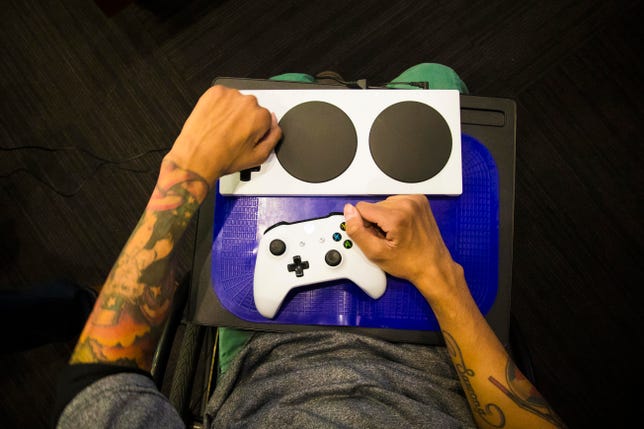By Ian Sherr
Mike Luckett is a lifelong gamer.
He started at the age of 5 nearly three decades ago, joining his older brother who was playing the original Super Mario Bros. on the Nintendo Entertainment System. Within a few years, he was playing games like Id Software’s 1992 Nazi prison break shooter, Wolfenstein 3D, and the followup sci-fi hit Doom.
Over the years, Luckett collected lots of consoles, including 1988’s Sega Genesis, 1994’s Sony PlayStation, 2005’s Xbox 360 and 2017’s Xbox One X. One of his favorite games was Vectorman, a shoot-’em-up adventure in which you’re a robot in the future protecting Earth from an uprising of evil robots.
But that all changed after the accident.
Luckett had been deployed overseas and working ordnance logistics for the Army in Iraq from 2010 through March 2011, when he came home. A few months later, in August, he was driving a motorcycle when things went wrong. The accident severed his C6 spinal cord, leaving him unable to use his legs. While he can move his hands, he lost control of his fingers.
And he could no longer use a computer. “I couldn’t even function, using the keys or using a trackpad or any of that,” Luckett said.
But he got really frustrated when he realized that while he was eager to try Activision Blizzard’s 2016 team-based shooter Overwatch, it required him to use a controller he couldn’t physically get his hands around. Luckett said that’s when he nearly decided to quit gaming.

He wasn’t the first gamer facing physical challenges. Since nearly the beginning of the industry, video games have been built with a few basic assumptions about the players: They can hear, they can see and they have two fully functioning hands. The first video game controllers, from the likes of Atari and Nintendo, were designed with joysticks and buttons.
To help them play on their own terms, some people in the disabilities community hacked together solutionsby breaking apart the controllers and attaching buttons, switches and other gizmos — changes that allowed them to send signals to the game using their feet or elbows, by bopping their head against a button or even by blowing into a tube. But building specialized controllers is onerous, expensive and time-consuming. Worse, the setup process doesn’t always work.
